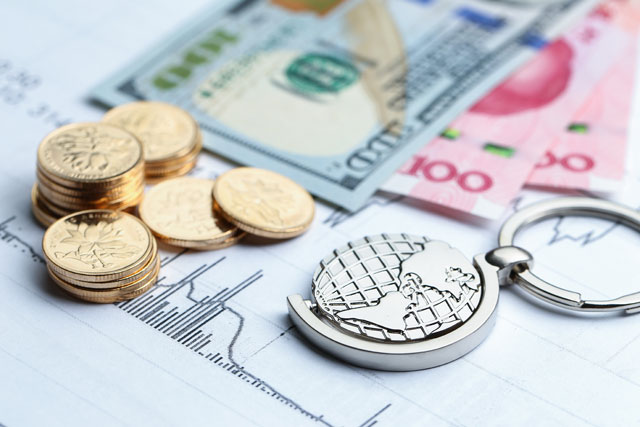China Has Enough Foreign Exchange Reserves

Those who are bearish about the China market often point to the country’s debt levels, others who are bullish shrug off these concerns by pointing to the country’s impressive foreign exchange reserves. But does China actually have too much forex reserves on its hands? Sheng Songcheng, a counselor of the People’s Bank of China, shares his views in this piece co-authored with Long Yu.
China currently has adequate foreign exchange reserves, which bodes well for its outbound investments. This is important because outbound investments can also contribute to higher efficiency in the allocation of the country’s wealth. Moreover, with gradual strengthening in the international standing of the Chinese currency, the RMB, China will be less dependent on foreign exchange reserves, reducing its need to hold large amounts of foreign currencies. The size of the country’s reserves should also be in line with its stage of economic development.
From Trading to Outbound Investments
China is transforming itself from a major trading nation into a significant power in outbound investments.
First, as a global trading power, China is already the largest exporter and second largest importer of goods, so there is not much to improve in terms of its share of world trade. In 2015, China accounted for 13.8% of global export of goods, up by about 10% over year 2000 and 10% higher than Japan which had the second largest foreign exchange reserves.
Second, with the slowdown of its economic growth, the return on investment in China has declined and the country may not be as attractive for foreign investments as it used to be. China’s FDI to GDP ratio grew from 0.97% in 1990 to 4.4% in 2007 but has been declining, on the whole, since the global financial crisis of 2008. In 2015, the ratio fell to 2.27%.
Moreover, China’s overseas financial assets are mostly owned by government departments in the form of foreign exchange reserves, while non-governmental sectors mainly own domestic assets and therefore need to increase their overseas assets. In terms of the structure of overseas assets, as of the end of 2016, foreign exchange reserves accounted for nearly half (47.9%) of China’s overseas assets. By contrast, more than 80% of Japan’s net overseas assets were owned by its household sector. Therefore, China’s household sector has a rather high demand for overseas assets. As of the end of 2015, overseas assets owned by China’s private sector were only 25.9% of GDP.[1]
Promising Future for RMB Internationalisation
As China is already one of the largest economic powers in the world, its overall national strength is the best endorsement for its sovereign credit. As of 2015, China – the second largest economy – accounted for 15% of the world’s GDP and contributed to 33.2% of the world economy. The Chinese economy is still growing, and much faster than the global average. Furthermore, China’s economic reform will unleash more of the country’s potential, as well as valuable opportunities for both inbound and outbound investments.
The RMB is now an international reserve currency. At the end of the first quarter of 2017, the IMF disclosed RMB holdings as foreign exchange reserves worldwide for the first time. Currencies listed separately by the IMF in its official quarterly survey of the Currency Composition of Official Foreign Exchange Reserves (COFER) are often widely recognised as reserve currencies. As of the end of 2016, the foreign exchange reserves in RMB were equal to around US$84.51 billion. According to the IMF’s survey in 2014-2015, there were more countries holding assets in RMB than there had been in 2011-2012, and the number of countries was as many as those holding foreign exchange reserves in Swiss Franc.
Third, the mechanism for determining the RMB exchange rate is gradually growing into a more market-oriented one. The 2017 Central Economic Working Conference and the Report on the Work of the Government both emphasised the necessity of enhancing exchange rate flexibility and holding on to the market-oriented reform of the exchange rate. Stability of the RMB’s status in the global monetary system would be enhanced by breaking down the unilateral revaluation of the RMB, injecting two-way volatility into it, because this improves, to some extent, the Chinese economy’s resilience to external shocks. In accordance with the latest BIS Triennial Survey, there was a rise in the RMB trading volume in the global foreign exchange market. As of April 2016, the daily trading volume in RMB grew from US$120 billion three years ago to US$202 billion, accounting for 4% of global foreign exchange trading volume, 2 percentage points higher than that of three years ago.
Fourth, as China seeks to gradually open its capital account, its bond market has also become increasingly more open in recent years. In cross-border transactions, the RMB is no longer solely used by businesses, but also by foreign institutions, individuals, etc.[2]
China Has Adequate Foreign Exchange Reserves
As the largest accumulator of foreign exchange reserves, China accounts for around 30% of the balance of global foreign exchange reserves, respectively 2.8 times and 5.4 times those of Japan and Saudi Arabia – the second and third largest – and nearly ten times that of India and Brazil.
China’s long-term and stable current account surplus still underpins the growth of its reserves. In 2016, China’s current account surplus was US$242.9 billion. Specifically, it amassed a surplus of US$485.2 billion from trade in goods and suffered a deficit of US$242.3 billion from trade in services. It is also worth noting that the return on increasing outbound investments will become a new source of surplus from international payments in the future.
Enough for a Rainy Day
The ability to cover the cost of imports (import cover) and solvency of short-term external debt (foreign exchange reserves/balance of short-term debts) are the two most conventional indicators of adequate foreign exchange reserves. Import cover is more applicable to countries with less open capital accounts. Vital for crisis management, short-term external debt solvency is more applicable to emerging markets.
In terms of import cover, as of the end of 2016, China’s reserves could cover 22.8 months’ worth of imports, much higher than the international warning line (3-4 months). In terms of short-term external debt solvency, as of the end of 2016, China’s reserves were 3.2 times more than its short-term debt (in local and foreign currencies) while the international warning line says it should not be less than the amount of short-term debt.
The IMF also has an analytical framework for assessing the adequacy of foreign exchange reserves. In accordance with this framework, the adequacy of foreign exchange reserves depends on the specific circumstances of each economy and the desirable size of reserves is related to the economic and financial structures of the country. For an emerging market, it’s best to take full account of its export volume, short-term debt, other debt and broad money supply and give them specific weights (these weights can be adjusted in accordance with the openness of its capital account, exchange rate regime, etc.) to measure the adequacy of its foreign exchange reserves and cover the risks of lower export proceeds, rolling over, capital flight, etc. Taking China’s current economy and financial arrangement into account, the desirable size of foreign exchange reserves for the country is around US$1.6 trillion to US$1.8 trillion. In other words, the current size of China’s foreign exchange reserves is 170.0% to 177.8% of the IMF’s standard levels. Furthermore, the RMB will be more flexible in the future. With a floating exchange rate mechanism, China will require an even smaller amount of reserves.
Outbound Investments
The proper utilisation and management of reserves, along with the rational allocation of overseas assets is in the national interest. To maintain liquidity, it’s impossible for reserves to generate high returns. Holding larger than required reserves may mean higher exchange risks. Therefore, excessive reserves can stunt the growth of national wealth. China should consider using part of its reserves for outbound investments and review how it justifies the amount of foreign exchange reserves it holds.
As the RMB is more and more widely used for international payment[3] and China has already implemented the policy of voluntary settlement of exchange, overseas assets owned by the household sector are accounting for an increasingly larger part of China’s trade surplus. Moreover, the reserves will also be used to support overseas investments and mergers of Chinese enterprises. As the reserves are used for the establishment of multilateral financial institutions and funds, such as the Asian Infrastructure Investment Bank and the Silk Road Fund, the balance of reserves will decline. Of course, such assets are still part of the Chinese government’s “ammunition depot”, or “shadow reserves.”
Despite the slowdown in the accumulation of reserves, China’s overseas assets are being more efficiently allocated. As prominent economist Fan Gang noted, “Less reserves don’t necessarily mean that more American dollars are moving out of China. But rather, they are kept in the accounts of commercial banks, which means that despite fewer official reserves, Chinese commercial banks can invest American dollars in bonds with higher returns and other financial assets.” The transformation of how the reserves are allocated can also help alleviate the critical problem of mismatched overseas assets and liabilities[4], resulting in sounder balance sheets for the household sector. In the past two years, China’s banking industry and non-financial corporate sectors readjusted their balance sheets and significantly reduced their short-term external debt. While the size of China’s reserves is shrinking, the net overseas assets of the country’s household sector have increased.
Finally, regarding the desirable size of reserves, based on regular international standards, it requires less than one fifth of our current reserves to support 3-4 months’ worth of imports, i.e., less than US$600 billion. From the perspective of satisfying the demand for short-term external debt solvency, as of the end of 2016, China had US$870.9 billion in short-term external debt, which required less than US$1 trillion in reserves. Based on the IMF’s framework on the appropriate size of reserves and weighted short-term external debt, other debt, broad money supply and exports, the desirable size of reserves for China should be no less than US$1.6 trillion. Therefore, China is holding far more reserves than needed. Of course, taking into account China’s national circumstances, industrial structure, status in the global economic and financial system and progress on internalisation of the RMB, China should hold more reserves than the international standard, but more is not necessarily better.
In short, China needs to reconsider how it justifies the size of its foreign exchange reserves, hold overseas assets in a more scientifically-based manner and allocate national wealth more efficiently.
Sheng Songcheng is a counselor of the People’s Bank of China and an adjunct professor at China Europe International Business School (CEIBS);
Long Yu is a research fellow at CEIBS Lujiazui Institute of International Finance (CLIIF).
(The views expressed in this article are those of the authors and do not necessarily represent those of their institutions.)
[1] Xie Yaxuan. “Can China Really Conceal Its Foreign Exchange Reserves in the Hands of Its People? “[J]. The Chinese Banker, February, 2017 (the 184th Issue).
[2] In 2015, China opened its bond market and inter-bank foreign exchange market to foreign central banks or monetary authorities, international financial institutions, and sovereign wealth funds (institutions similar to central banks). In February, 2016, the bond market was further opened to foreign private institutional investors without investment quota.
[3] In 2016, 21.5% of the international trade volume of China was settled in CNY and the amount of currencies exchanged for export declined. Source: Wang Youxin. The Truth and Falsity, Path and Power, and Joy and Sorrow of Declined Reserves. Central Bank Observers, February 28th, 2017.
[4] For details, please see “China’s Salient Issue of Mismatched Overseas Assets and Liabilities” by Liu Xi Originally published in issue 12 of China Finance, 2016.













